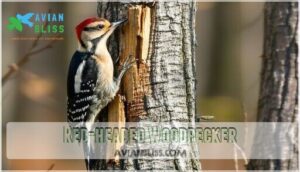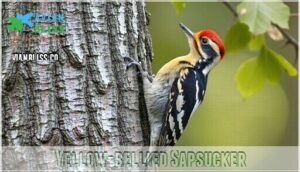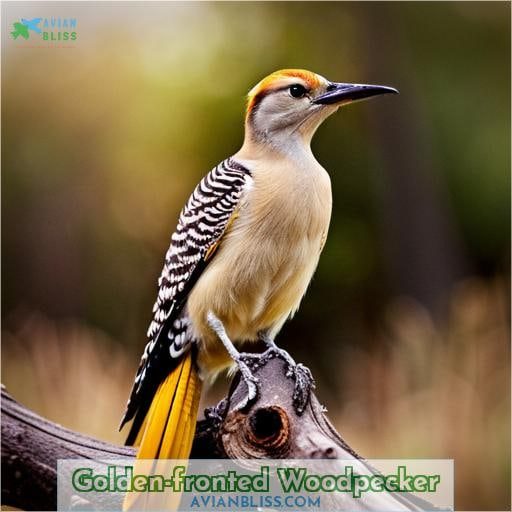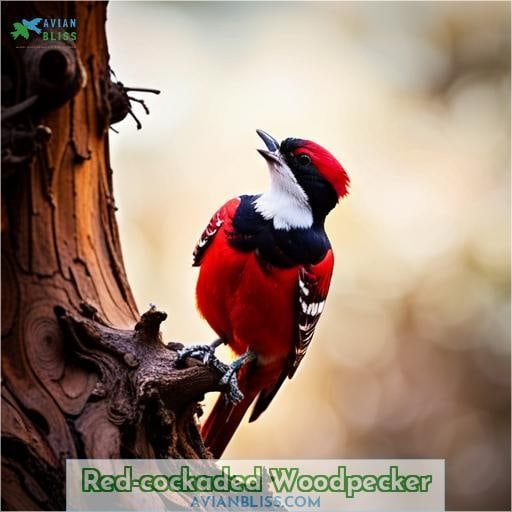This site is supported by our readers. We may earn a commission, at no cost to you, if you purchase through links.
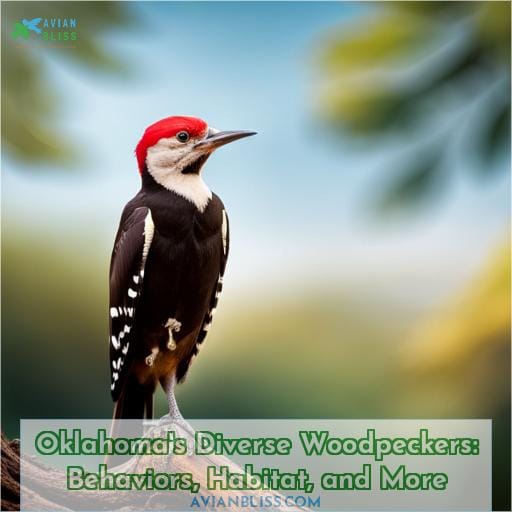
Amidst the rich tapestry of woodlands and backyards, the resplendent Red-bellied Woodpecker asserts its presence with peachy-red caps and a distinct black-and-white striped allure. It is an emblem of year-round vigor, gracing both forests and feeders. It is enticed by suet blocks, peanuts, and sunflower seeds.
Meanwhile, the Red-headed Woodpecker, a striking apparition with its vivid crown, captivates as it soars through the skies. Its nesting habits and behavior unravel a fascinating narrative of life in Oklahoma’s heartlands.
Venture deeper, and the diminutive Downy Woodpecker graces the scene. Its subtle charm is underscored by size and intricate patterns. Enigmatic in their foraging pursuits, these feathered marvels explore Oklahoma’s expanse.
The enchanting Yellow-bellied Sapsucker unveils its plumage amidst sap wells and migratory trails. Amidst this mosaic, the Hairy Woodpecker stands apart. Its distinguishing bill shape and size accentuate its allure.
Ponder the intriguing duality of the Northern Flicker, a creature of two variations, and marvel at the exquisite detailing of the Golden-fronted Woodpecker’s plumage.
As you immerse in this avian odyssey, the plight of the Red-cockaded Woodpecker unfolds. It inspires conservation endeavors to safeguard its unique social structure and habitat.
Engage with this profound narrative, a gateway to liberation through understanding, as you unravel the secrets of Oklahoma’s diverse woodpecker symphony.
Table Of Contents
- Key Takeaways
- Red-bellied Woodpecker
- Red-headed Woodpecker
- Downy Woodpecker
- Yellow-bellied Sapsucker
- Hairy Woodpecker
- Northern Flicker
- Golden-fronted Woodpecker
- Red-cockaded Woodpecker
- Ladder-backed Woodpecker
- Frequently Asked Questions (FAQs)
- Red-bellied Woodpecker:**
- Do Red-bellied Woodpeckers migrate during the winter months?**
- What are some specific behaviors that distinguish the Red-bellied Woodpecker from other woodpecker species?**
- Red-headed Woodpecker:**
- What are the main factors contributing to the decline in the Red-headed Woodpecker population in Oklahoma?**
- Are there any conservation efforts underway to protect and restore the Red-headed Woodpecker’s habitat?**
- Downy Woodpecker:**
- How do Downy Woodpeckers adapt their behaviors and habits to different seasons throughout the year?**
- Conclusion
Key Takeaways
- The population of the Red-headed Woodpecker is declining due to habitat loss.
- The Red-cockaded Woodpecker is an endangered species that nests in pine trees.
- Woodpecker conservation is critical for preserving habitats and maintaining species diversity.
- Conservation efforts are vital to protect the unique and valuable woodpecker species in Oklahoma.
Red-bellied Woodpecker
Nestled within the diverse avian tapestry of Oklahoma, the Red-bellied Woodpecker, a remarkable member of the Picidae family, unveils an array of captivating traits. It favors woodlands and backyards graced with towering, decaying trees as its habitat.
The woodpecker presents a peachy-red crown that distinguishes it with an air of elegance.
Delving into its feeding habits and diet, one finds this woodpecker’s penchant for suet and its insatiable appetite for insects. It is complemented by its adeptness at sapping tree trunks, forming an integral part of its ecological role.
Notably, its intriguing behaviors encompass the mesmerizing drumming resonating through the woodland. This rhythmic code signals its presence and territorial prowess, offering observers a glimpse into the intricacies of its social dynamics and adaptations.
Habitat and Physical Characteristics
Imagine exploring lush woodlands and pine savannas, where you’ll spot the bright red heads of Red-headed Woodpeckers amidst the open woods, their vibrant plumage a striking contrast to the green canopy above.
- Habitat Preservation: Red-headed Woodpeckers thrive in open woodlands and pine savannas.
- Woodpecker Behavior: Their distinctive red heads make them easy to identify.
- Species Differentiation: Their habitat preferences set them apart from other woodpecker species.
- Conservation Efforts: Due to declining populations, habitat preservation is crucial for their survival.
Feeding Habits and Diet
Picture yourself as a curious observer, watching these vibrant creatures indulge in their culinary escapades, exploring the delectable world of insects hidden beneath the bark and savoring the succulent offerings of the trees they tap into.
The red-bellied woodpecker, along with its counterparts like the downy and hairy woodpeckers, exhibits a diverse and adaptable diet. These woodpeckers are master foragers, utilizing their strong, chisel-like bills to uncover insects such as beetles, ants, and caterpillars from crevices in the bark.
But their feeding preferences don’t stop at insects alone. They are skilled at extracting seeds and fruits as well, making them opportunistic omnivores.
This dietary adaptation allows them to thrive in a variety of habitats, from woodlands to backyards. Additionally, the availability of suet feeders further complements their diet, providing an energy-rich source that attracts them to human-populated areas.
These bird feeding habits showcase their remarkable ability to find nourishment from multiple sources, a testament to their resilience and mastery of their environment.
Interesting Facts and Behaviors
Discover a fascinating glimpse into the world of these vibrant birds by uncovering their unique behaviors and intriguing facts. Woodpecker drumming resonates through Oklahoma’s woodlands, a rhythmic display to establish territory and attract mates.
Their suet preferences make feeders a haven, while their vocalizations and calls vary from sharp ‘peek’ sounds to melodic trills. Nesting intricacies involve excavating cavities in dead trees, and some species even create multiple roost holes.
Migratory patterns add to the wonder of observing these captivating creatures, enhancing birdwatching experiences in Oklahoma’s diverse landscape. Keep an eye out for Lewis’s Woodpecker, recognized for its distinctive flight style and stunning green and pink plumage.
Red-headed Woodpecker
Introducing the Red-headed Woodpecker, a striking avian species found in the woodpecker-rich landscapes of Oklahoma. With its vibrant red head and distinctive black and white body, this woodpecker species catches the eye of bird enthusiasts across the region.
The Red-headed Woodpecker’s presence spans open woods and pine savannas; however, concerns about its declining population highlight the pressing need for conservation efforts. This woodpecker species showcases intriguing nesting habits, often excavating its nesting cavity in dead trees, while its behavior involves energetic flights and agile foraging maneuvers.
Appearance and Distribution
Get ready to marvel at the captivating allure of the Red-headed Woodpecker as its striking red crown and contrasting black and white plumage adorn open woods and pine savannas, creating a sight that’s as bold and unforgettable as a sunset over endless horizons.
This distinctive woodpecker species in Oklahoma exhibits intriguing features:
Migration Patterns: Some Red-headed Woodpeckers migrate, moving from northern areas to more temperate regions in winter.
Vocalizations and Calls: Their calls include rattling and piping sounds, often heard during courtship and territorial disputes.
Nesting Preferences: They excavate nest cavities in dead trees, displaying a preference for open woodlands.
Feeding Adaptations: These woodpeckers have strong bills suited for catching insects and foraging for fruits and nuts.
Habitat Diversity: Red-headed Woodpeckers thrive in a variety of habitats, from woodlands to savannas, displaying adaptability and resourcefulness in their choice of homes.
Experience the Red-headed Woodpecker’s dynamic presence in the realm of Oklahoma woodpeckers, a testament to nature’s intricate interplay of form and function.
Conservation Status and Threats
Observe the current conservation status and potential threats faced by the Red-headed Woodpecker, contemplating its pivotal role within its ecosystem. The Red-headed Woodpecker, a captivating woodpecker species in Oklahoma, confronts critical conservation challenges.
Its population trends reveal concerns as habitat loss due to human impacts looms large. Bird conservation efforts have rallied, focusing on safeguarding habitats and providing nesting boxes to counter these threats and preserve this remarkable endangered species.
Nesting Habits and Behavior
Explore the intricate world of nesting habits and behavior as the captivating red-headed woodpecker thrives in its natural realm. This woodpecker exhibits remarkable nesting cavity excavation skills, crafting secure homes within trees.
Courtship rituals are a mesmerizing display, with striking aerial maneuvers and vocalizations. After mating, diligent parental care ensues, ensuring the fledglings’ well-being. Drumming behavior resonates, communicating territorial boundaries and attracting mates.
In the woodpeckers of Oklahoma, this distinctive behavior unfolds, portraying a dynamic interplay of survival and communication.
Downy Woodpecker
Delving into the realm of Downy Woodpeckers, you’ll encounter a diminutive marvel characterized by its intricate size and physical traits. With a compact build adorned by intricate black and white patterns, the Downy Woodpecker (Dryobates pubescens) stands as one of Oklahoma’s captivating avian inhabitants.
This species finds its niche across a diverse array of habitats, spanning open woodlands to urban neighborhoods, showcasing its remarkable adaptability. Its feeding and foraging behavior, a masterclass in agility, involves an adept exploration of tree bark for insects, often accompanied by its distinctive soft tapping, rendering it a true spectacle in Oklahoma’s avian tapestry.
Size and Physical Features
Immerse yourself in the world of these remarkable avian creatures as you uncover the intricacies of their size and physical attributes, painting a vivid picture of their captivating presence in the lush landscapes.
Woodpecker Size Variations: From the diminutive Downy Woodpecker to the impressive Pileated Woodpecker, woodpeckers in Oklahoma span a range of sizes, each finely adapted to their unique habitats.
Physical Adaptations for Tree Climbing: With zygodactyl feet and strong claws, woodpeckers effortlessly navigate vertical surfaces. Their rigid tail feathers serve as stabilizers during climbing and drumming.
Feather Coloration Patterns: Woodpeckers exhibit striking black and white patterns on their feathers, aiding in camouflage, signaling, and species recognition. Some, like the Northern Flicker, also possess vibrant coloration.
Woodpecker Bill Diversity: Bills vary in shape and length based on diet and foraging strategies. While the Pileated Woodpecker’s long chisel-like bill aids in excavating, the slender bill of the Ladder-backed Woodpecker is suited for probing crevices.
Adaptations for Drumming Behavior: Woodpeckers communicate through drumming on resonant surfaces, signaling territory and attracting mates. Their sturdy skulls, cushioned by specialized structures, protect against brain injury during rapid drumming.
Witness the spectacle of woodpeckers’ size diversity, exquisite feather patterns, and specialized adaptations as they thrive in the landscapes of Oklahoma.
Habitat and Range
Nestled within the tapestry of nature’s symphony, the lively forests and woodlands become the stage for the Downy Woodpecker’s endeavors, where its agile presence adds rhythm to the ancient dance of life.
Found throughout Oklahoma, this diminutive woodpecker frequents open woodlands, parks, and even urban areas. To attract these delightful birds, consider providing suet feeders, native plants, and a water source.
Listen for their distinctive pik calls as they harmonize with the wilderness, a reminder of the interconnectedness of all beings.
Feeding and Foraging Behavior
Delve into the world of these feathered artisans as they skillfully navigate their habitat, demonstrating their feeding and foraging behavior with finesse. Downy Woodpeckers, prolific in Oklahoma’s birding landscape, exhibit versatile foraging techniques.
They favor insects, particularly wood-boring beetles, and glean them from tree bark crevices. Their food preferences shift seasonally, encompassing fruits and berries. These adaptable birds often join mixed-species flocks, fostering unique interactions with other bird species.
In their quest for sustenance, Downy Woodpeckers exhibit precise feeding site selection, contributing to their role as captivating contributors to Oklahoma’s avian tapestry.
Yellow-bellied Sapsucker
Delve into the world of the Yellow-bellied Sapsucker, a distinctive woodpecker species gracing the landscapes of Oklahoma. Recognizable by its striking plumage, this woodpecker boasts a black and white back, complemented by a distinctive red crown and a subtle yellowish belly.
Its peculiar behavior is exemplified by the sap-well rows it meticulously creates on tree trunks, a remarkable feat linked to its sap-based diet. As the seasons shift, observe the Yellow-bellied Sapsucker’s migratory patterns, with a presence in Oklahoma during the non-breeding months, making it an intriguing addition to the state’s avian tapestry.
Plumage and Identification
Explore the vivid world of woodpecker plumage and identification, where each species dons its own unique attire, captivating both the eye and the imagination.
Plumage Variations: From the striking red head of the Red-headed Woodpecker to the delicate yellow belly of the Yellow-bellied Sapsucker, woodpeckers display an array of colors and patterns that define their identity.
Field Identification Tips: Pay attention to size, color patterns, and distinctive markings like the ladder-like back of the Ladder-backed Woodpecker for accurate identification.
Vocal Distinctions: Beyond appearances, listen for the distinct calls and drumming patterns each woodpecker species produces, aiding in precise recognition.
Camouflage Adaptations and Seasonal Plumage Changes further enhance their allure, a testament to their evolutionary prowess.
In this world of feathered marvels, knowledge grants you the power to unravel their hidden stories.
Sap-Well Behavior and Diet
Discover the captivating Yellow-bellied Sapsucker’s world as it unveils its unique sap-well behavior and diverse diet. This bird brings intrigue to your bird-watching adventure! With precision, it excavates sap wells, a vital source of sap and insects.
Seasonally, its diet shifts, ranging from sap to insects and fruits. The sapsucker’s foraging techniques, like drumming and calls, facilitate communication and territory establishment. Yet, its methods impact trees, influencing their health and ecology, adding an extra layer of wonder to this species.
Migratory Patterns and Distribution
Diving into this subject, you’ll find that the Yellow-bellied Sapsucker displays remarkable migratory patterns, traveling distances of up to 1,600 miles to reach its wintering grounds.
- Migratory Routes: These woodpeckers embark on intricate journeys, navigating across North America.
- Seasonal Movements: They leave their breeding grounds in northern regions during autumn.
- Wintering Locations: They settle in southern regions where milder conditions and abundant food prevail, showcasing their adaptability to changing environments.
Hairy Woodpecker
Delve into the realm of the Hairy Woodpecker, a fascinating denizen of the woodpecker realm in Oklahoma. Sharing certain similarities with its counterpart, the Downy Woodpecker, the Hairy Woodpecker captivates with its distinct differences in size and bill structure, offering a nuanced exploration into the intricacies of avian morphology.
Similarities to Downy Woodpecker
Take a moment to uncover the intriguing similarities between the Hairy Woodpecker and the Downy Woodpecker as we delve into their captivating traits.
Downy vs Hairy: While these two woodpecker species may seem remarkably alike, keen observers note their subtle differences.
Vocalizations Comparison: Their calls resonate through woodlands with slight variations, allowing keen ears to distinguish between the two.
Nesting Similarities: Both species prefer excavating cavities in trees for nesting, showcasing their shared nesting behavior.
Feeding Techniques: Their foraging techniques align closely, as they expertly seek insects by probing bark crevices.
Behavioral Interactions: Often found in mixed flocks, these woodpeckers exhibit social behavior, engaging in fascinating interactions with other birds.
Differences in Size and Bill Shape
Sure thing! Picture this: the Hairy Woodpecker struts onto the scene with an air of ‘I’m here, deal with it,’ showing off its larger size and that chisel-like bill that says, ‘I mean business.’ Unlike its smaller counterpart, the Downy Woodpecker, the Hairy Woodpecker boasts a more substantial presence, allowing it to tackle tougher tasks with its robust bill.
This size difference isn’t just happenstance; it’s an adaptation honed by evolutionary pressures. This chisel-like bill isn’t just for show either; it’s a finely tuned tool for extracting insects from bark crevices.
With these adaptations, the Hairy Woodpecker exerts its influence on the ecosystem by helping control insect populations.
And when it comes to communication, these woodpeckers have a range of vocalizations, from drumming on trees to calls that establish territory. Their prowess lies not just in their appearance, but in their ecological role and communication skills, granting them a commanding presence in their woodpecker realm.
Northern Flicker
Delving into the fascinating realm of the Northern Flicker, you’ll uncover a captivating tale of diversity represented by its Yellow-shafted and Red-shafted variations. These distinctive color forms stand as markers of geographic variation, with the Yellow-shafted inhabiting the eastern expanse and the Red-shafted gracing the western landscapes of North America.
Beyond their vibrant hues, these flickers exhibit intriguing breeding and nesting behavior, often selecting natural cavities or excavating their own burrows in trees to create secure nesting sites, enriching the woodpecker symphony of Oklahoma’s wilderness.
Yellow-shafted and Red-shafted Variations
Explore the vibrant world of Northern Flickers as you delve into the fascinating variations between the Yellow-shafted and Red-shafted varieties. These variations go beyond mere plumage distinctions, encompassing ecological roles, habitat preferences, and behavioral adaptations.
The Yellow-shafted Northern Flicker boasts vivid yellow wing and tail feathers, often found in eastern woodlands, while the Red-shafted variety flaunts striking red hues in the same areas as the western counterpart.
These adaptations are windows into the evolutionary intricacies that empower these woodpeckers to thrive across diverse landscapes.
Breeding and Nesting Behavior
Delve into their fascinating world as these vibrant birds meticulously craft their homes, fashioning intricate nesting cavities in the heart of mature forests. During the breeding season, Northern Flickers exhibit intriguing behaviors that revolve around courtship rituals and nesting site selection.
Their courtship displays involve distinctive calls, drumming on resonant surfaces, and aerial acrobatics. Once a suitable nesting site is found, the female flicker takes charge of the egg incubation process, diligently warming the eggs for about 11 days.
The fledgling development marks an exciting phase as the young birds grow rapidly, nourished by the diligent efforts of their parents.
Golden-fronted Woodpecker
Delve into the realm of the Golden-fronted Woodpecker, a captivating denizen of the woodpecker fraternity in Oklahoma. This species boasts a distinct geographic range, predominantly gracing the tapestry of Mexico and the open woodlands of central Texas.
Its appearance and plumage are equally noteworthy, adorned with black and white bars that elegantly embellish its wings and back, while a conspicuous yellow face and a fiery red head patch contribute to its resplendent allure.
Geographic Range and Distribution
Discover the expansive territories that the remarkable Golden-fronted Woodpecker calls home, revealing the captivating diversity of its geographic range and distribution. This distinctive woodpecker species boasts a wide range across its habitat, primarily found in central Texas and parts of Mexico.
Engage with its fascinating behaviors as you observe its migration patterns, vocalization patterns, and interactions with other bird species. From breeding seasons characterized by intricate courtship calls to its versatile foraging techniques, the Golden-fronted Woodpecker offers a compelling insight into avian life.
Appearance and Plumage
Immerse yourself in the vibrant world of plumage as you uncover the resplendent array of colors and patterns that adorn these remarkable avian inhabitants. The Golden-fronted Woodpecker, a captivating species found in central Texas and occasionally in Oklahoma, boasts a striking appearance.
Its yellow face, accompanied by bold black and white bars, immediately catches the eye. Throughout the seasons, subtle variations in markings occur, accentuating its allure. Molt patterns contribute to this species’ visual intrigue, while distinctive calls and adept camouflage strategies reveal its profound adaptation to its environment.
Red-cockaded Woodpecker
Delving into the realm of the Red-cockaded Woodpecker, one encounters a species ensnared in the precarious grasp of endangerment, prompting an earnest symphony of conservation efforts.
These avian denizens are characterized by their diminutive size, ebony and ivory plumage, and the distinctive small red spot adorning male foreheads. They stand emblematic of the challenges posed by habitat loss and fragmentation.
Navigating the intricate tapestry of longleaf pine ecosystems, these woodpeckers intricately carve out their nesting cavities in living pines. They foster a unique cohabitation with these towering sentinels of the southern landscape, all while demonstrating their distinctive cooperative breeding behavior and intricate social structure that defines their very survival.
Endangered Status and Conservation Efforts
Explore the remarkable efforts underway to safeguard the endangered Red-cockaded Woodpecker, ensuring its survival for generations.
- Endangered Status Overview: The Red-cockaded Woodpecker’s dwindling numbers earned it an endangered status, signaling the urgency of conservation.
- Conservation Challenges: Habitat loss, particularly due to deforestation, poses a significant threat to this species.
- Population Decline Factors: Urbanization and altered fire regimes disrupt their pine forest habitats, hampering their nesting and foraging.
- Recovery Initiatives: Collaborative projects focus on preserving mature pine ecosystems, installing artificial cavities, and controlled burns to enhance their habitat’s health.
Habitat and Nesting Sites
Delve into the world of these remarkable avian creatures by understanding their preferred habitats and nesting preferences. Witness how their intricate nest cavities, often excavated in mature forests, serve as critical shelters for raising their young, showcasing the woodpeckers’ exceptional adaptation to their environment.
Migration Patterns:
Migrate locally within their preferred habitats, primarily in pine forests.
Vocalizations and Calls:
Employ a diverse range of calls, including chattering and soft pecks, for communication and territory defense.
Nest Cavity Excavation:
Exhibit impressive excavating abilities, crafting nesting cavities in mature pines with resin barriers to deter predators.
Feeding Preferences:
Predominantly feed on insects, particularly beetles and ants, found in tree bark.
Impact on Ecosystem:
Play a crucial role in pine forest ecosystems by creating cavities that other species use after they’ve abandoned them, contributing to biodiversity.
Elevate your understanding of the Red-cockaded Woodpecker’s intricacies, from their habitat selection to their nurturing behaviors, and grasp their significant influence on the ecosystem they inhabit.
Unique Behavior and Social Structure
Discover the captivating world of the Red-cockaded Woodpecker by uncovering its unique behaviors and fascinating social structure that sets it apart from its avian counterparts.
Woodpecker Vocalizations: This species communicates through distinct calls, conveying territorial boundaries and warnings against predators.
Breeding Season Activities: During breeding, males showcase their prowess by drumming on trees, attracting mates with rhythmic patterns.
Courtship Rituals: Elaborate displays involve aerial chases and synchronized flights, solidifying pair bonds.
Nesting Site Selection: These woodpeckers exhibit an unparalleled nesting strategy, often choosing living pine trees with resin wells to deter predators.
Feeding Interactions: Cooperative foraging is common, where family groups cooperate to locate insects beneath the bark, enhancing their efficiency.
Immerse yourself in the enigmatic world of the Red-cockaded Woodpecker, where vocalizations, courtship dances, and collective hunting rituals unveil the intricate tapestry of their social dynamics.
Ladder-backed Woodpecker
Embark on a journey through the vibrant avian tapestry of Oklahoma, where the Ladder-backed Woodpecker, with its captivating presence, adorns the state’s diverse woodlands and neighborhoods. This woodpecker, distinguished by its striking black and white barred back, exudes an aura of both elegance and utility.
Endemic to the western parts of the state, the Ladder-backed Woodpecker showcases a remarkable array of behaviors that highlight its adaptability. Foraging predominantly on insects, this species demonstrates an affinity for mealworms and peanut butter, making it a delightful visitor for those who seek to attract its kind.
Nesting habits of the Ladder-backed Woodpecker are equally fascinating. It carves out its nests in dead trees, displaying resourcefulness in utilizing available habitats. Vocalizations of this woodpecker species are not to be overlooked – its distinct calls serve both communication and territorial marking purposes.
As this feathered denizen moves through its habitat, its unique flight style captures the essence of freedom, epitomizing the untamed spirit of the woodlands it calls home.
Frequently Asked Questions (FAQs)
Red-bellied Woodpecker:**
Investigate whether the Red-bellied Woodpecker’s peachy-red cap and attraction to suet and dead trees make it a recognizable resident in woodlands and backyards.
Do Red-bellied Woodpeckers migrate during the winter months?**
Red-bellied Woodpeckers do not migrate during the winter months. They exhibit a sedentary behavior, staying within their habitat range. Their adaptability to various food sources and climates enables their year-round presence, offering insights into their resilient survival strategy.
What are some specific behaviors that distinguish the Red-bellied Woodpecker from other woodpecker species?**
Distinguish the Red-bellied Woodpecker by its peachy-red cap, which can be found in woodlands and backyards. It is attracted to suet and dead trees, and it exhibits a distinct peek call. Additionally, it has a black and white back, which sets it apart from other woodpecker species.
Red-headed Woodpecker:**
The Red-headed Woodpecker (Melanerpes erythrocephalus) stands out with its vibrant red head, contrasting black and white body. It is found in open woods and pine savannas, and its population is declining, emphasizing the need for conservation efforts.
What are the main factors contributing to the decline in the Red-headed Woodpecker population in Oklahoma?**
Investigate: Red-headed Woodpecker decline. Factors: Habitat loss due to deforestation and urbanization. Competition from invasive species. Changes in insect prey availability. Nest site competition.
Are there any conservation efforts underway to protect and restore the Red-headed Woodpecker’s habitat?**
Amidst the captivating world of Oklahoma’s woodpeckers, the pressing question arises: What strides are being taken to safeguard the habitat of the imperiled Red-headed Woodpecker? Delve into the ongoing conservation endeavors aimed at restoring its dwindling population.
Downy Woodpecker:**
The Downy Woodpecker (Dryobates pubescens), a diminutive species with black and white coloration, frequents open woodlands. Notably small and agile, it displays distinct spring and summer activity, often joining mixed flocks during winter months.
How do Downy Woodpeckers adapt their behaviors and habits to different seasons throughout the year?**
Downy Woodpeckers adeptly modify behaviors according to seasons. In spring and summer, their energetic foraging is prevalent, often in mixed flocks.
Conclusion
As you journey through the diverse woodpecker species that grace the landscapes of Oklahoma, a vivid tapestry of behaviors, habitats, and distinctive characteristics comes to life.
From the striking red-capped allure of the Red-bellied Woodpecker to the vibrant hues of the Red-headed Woodpecker, the woodpeckers of Oklahoma paint a vivid portrait of avian diversity.
The secretive yet familiar Downy Woodpecker, with its small stature and intricate plumage, finds solace in open woodlands, while the Yellow-bellied Sapsucker’s red markings and sap-seeking behavior stand out against the verdant backdrop.
The Hairy Woodpecker, a close kin of the Downy, exhibits subtle differences that keen observers can discern.
The Northern Flicker’s dual variations, the Yellow-shafted and Red-shafted, reflect the complexity of nature’s palette, while the enigmatic Pileated Woodpecker commands attention with its crow-sized presence and raucous excavations.
The endangered Red-cockaded Woodpecker, a symbol of conservation efforts, navigates the dwindling pine forests with resilience.
Venturing further, the unique behaviors of the Ladder-backed Woodpecker and the iridescent charm of the Golden-fronted Woodpecker underscore the intricate web of ecological roles these species fulfill.
Each woodpecker’s story is a testament to the interplay between habitat and adaptation, form and function.
So, when the rhythmic tapping of beaks against tree trunks echoes through Oklahoma’s woodlands and neighborhoods, it’s a reminder of the hidden lives and remarkable feats of these avian architects. Their presence enriches ecosystems, spreads joy to bird enthusiasts, and underscores the importance of preserving the delicate balance of nature.
Amidst the cacophony of bird songs and vibrant plumage, the woodpeckers of Oklahoma stand as a testament to the intricate beauty of the natural world.


